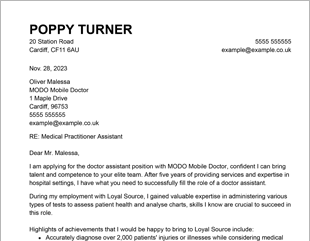The 6 Key Parts of a Cover Letter
Creating a persuasive cover letter is an important way to ensure you get invited to job interviews. Here’s our breakdown of the six parts of a cover letter.
Creating a persuasive cover letter is an important way to ensure you get invited to job interviews. Here’s our breakdown of the six parts of a cover letter.





OUR USERS HAVE BEEN HIRED BY
A cover letter acts as a supplementary document in a job application, providing direct contact with the hiring managers in charge of filling a role. Generally attached to a job seeker’s CV, a cover letter serves three main purposes:
In that vein, it’s important to write a tailored cover letter for each application that you make during a job search. By tailoring your cover letter and CV to each job description you can maximise the three benefits listed above.
You should write your CV first when undertaking a new job application, so you’ll know specific points to highlight in your cover letter. The average cover letter will include these six features:
The salutation should be at the very top of the page, under the header containing the job seeker’s name, email, phone number and professional portfolio links such as LinkedIn. The salutation is essentially a direct address of the recruiter. As such, you should try to use the hiring manager’s name rather than a generic salutation like “Dear Hiring Manager” or “To Whom It May Concern”. A more personal salutation shows you have done your research.
The first paragraph of a cover letter’s main body should hook the recruiter and encourage them to read further. The most common ways in which to do this are to lead off with a notable achievement or focus on your passion for the role that you are applying for. You could even do both and discuss why the company culture appeals to you. For example, you could write: “A dedicated and driven sales associate with a track record of exceeding targets by 10% or more, I have long admired [company name] for the way they reward hard working employees.”
The second paragraph should go into detail about what you have to offer to a potential employer. Think about your unique achievements and highlight the key competencies from your CV, but don’t copy and paste any sections. This is your chance to expand on the most important parts of your work experience and skills sections.
Some cover letters will have more paragraphs if the job seeker has a lot of professional experience. It’s also perfectly acceptable for the third paragraph to be the closing paragraph (see below). This paragraph should showcase what you know about the company and discuss the ways in which you can help further their goals. For example: “As [Company Name] has declared its intent to expand into international markets, as a bilingual marketing specialist, I could play a key part in this process.”
Your closing paragraph should be short and clear, including a call to action which prompts a hiring manager to reach out to you for an interview or further discussion. You can do this with a forthright statement like “I look forward to speaking with you” or a more gentle statement like “I hope to hear from you soon.
Every cover letter should have a professional sign-off such as “Yours Sincerely” or “Warm Regards” will be preferable. End your cover letter by signing your full name. In an electronic cover letter you can simply type it, but if you are ever required to provide a hard copy of a cover letter you should sign it by hand.
No. Sending a generic cover letter to a hiring manager could actually damage the prospects of your job application. Take the time to personalise your cover letter each time you apply to a job posting to show that you are enthusiastic.
You can mention your personal life as long as it is relevant to the job description that you are applying for. You should not simply tell a personal story. A cover letter cannot be written in the same way as a college personal statement.
Cover letter templates can be incredibly useful for people who:
CVHelp has a range of free cover letter templates that you can browse.
We personalize your experience.
We use cookies in our website to ensure we give you the best experience, get to know our users and deliver better marketing. For this purpose, we may share the information collected with third parties. By clicking “Allow cookies” you give us your consent to use all cookies. If you prefer to manage your cookies click on the “Manage cookies” link below.